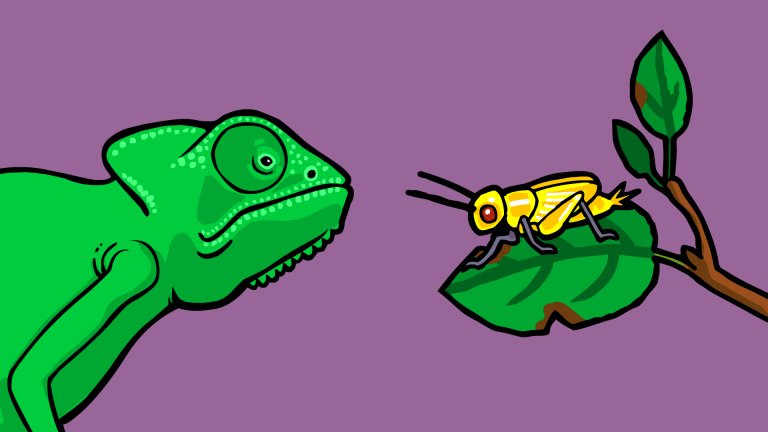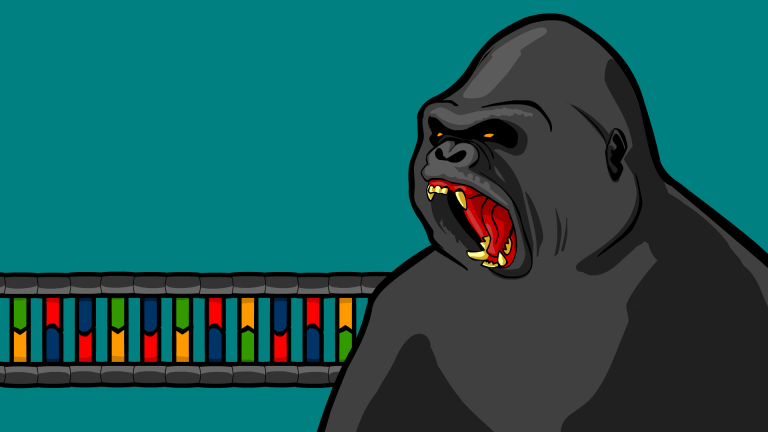Overview
Gene Duplications are a common starting point for the evolution of new genetic information. When gene duplications occur, they dramatically lengthen the genetic code of an individual. As point mutations add up in the duplicated region across generations, entirely new genes with new functions can evolve.
Scientists have directly and indirectly observed gene duplication events in the lab and in wild populations of plants, animals and microbes, many times over. Because of this, they can use known signatures of gene duplication events to understand how a large variety of genes evolved in plants and animals alive today.
In this video we see three examples of gene duplications resulting in new traits for the creatures who inherit them: the evolution of a venom gene in snakes, the evolution of leaf digestion genes in monkeys, and the evolution of burrowing legs in hunting dogs.
NOTES:
======================
How do new genes evolve?
======================
Read about the many different ways in which entirely new genes come into existence: http://www.nature.com/scitable/topicpage/origins-of-new-genes-and-pseudogenes-835
================================
Observed gene duplications In Bacteria
================================
Here, gene duplication was directly observed from generation to generation. After duplication, a new function was seen to evolve.
http://www.ncbi.nlm.nih.gov/pmc/articles/PMC4392837/
======================================
Observed or inferred gene duplications In mice
======================================
Here, genetically identical mice were allowed to breed for several generations and then gene number variations were compared in the final populations.
http://www.ncbi.nlm.nih.gov/pmc/articles/PMC2920193/
http://journals.plos.org/plosone/article?id=10.1371/journal.pone.0012839
Here, gene number variations were compared among populations of wild mice.
http://www.ncbi.nlm.nih.gov/pmc/articles/PMC4042557/
===========================
Factor X Snake venom evolution
===========================
Factor X is what it’s called in the blood.
Trocarin D is what it’s called in the venom gland.
http://onlinelibrary.wiley.com/doi/10.1111/j.1538-7836.2006.02266.x/abstract
==========================
Snake venom is modified saliva
==========================
The venom gland is derived from what are called “Dental Glands” which are found in reptiles and produce oral secretions like our saliva glands. In particular, the venom gland appears to be homologous to the Duvernoy’s gland in non-venomous snakes. Little research has been done on the function of Duvernoy’s glands in non-venomous snakes but in most species, its secretions appear to be used as lubrication to aid in swallowing. Enzymes are also produced that may aid in killing, paralyzing, and digesting prey but these functions appear to be limited in their power and are only found in certain species.
http://people.whitman.edu/~jacksok/ZJLS.pdf
http://www.public.wsu.edu/~kkardong/Web%20of%20KVK_06b/Publications/Evolution_venom_app82.pdf
============================
How do blood clots form?
============================
Read an overview of how the blood clotting cascade functions and may have evolved:
http://www.millerandlevine.com/km/evol/DI/clot/Clotting.html
Watch a cool 3D animation showing how Factor X interacts with other molecules and structures in the blood to form clots!
For Teachers
The content of this video meets criteria in the following Disciplinary Core Ideas defined by Next Generation Science Standards. Use our videos to supplement classroom curriculum.
Contributors
Our videos benefit from guidance and advice provided by experts in science and education. This animation is the result of collaboration between the following scientists, educators, and our team of creatives.
Team
- Jon Perry
- Jeremiah Deasey
- Anthony Danzl
- Rosemary Mosco
- Jordan Collver
- Tyler Proctor
- Zaid Ghasib
- Katie Hick
Advisors
- Jianzhi "George" Zhang, PhD
- Joanna Masel, PhD
- Kini R Manjunatha, PhD
- Nicholas Casewell, PhD
Transcript
As we’ve learned in previous animations, a gene is a long stretch of DNA containing information that codes for something, usually a protein or group of proteins. Point mutations can edit small bits of information within a gene, modifying the type of protein it builds. These small edits are extremely important for evolution, but if we compare the genes of say, a flower to those of a dolphin, we see that even though they do have many genes in common, dolphins also have entirely new genes not found in flowers, and flowers have genes that can’t be found in dolphins. This observation forces us to ask the question, how do entirely new genes evolve? Point mutations are clearly not enough.
Well, it turns out that over the years, scientists have discovered many natural mechanisms for the evolution of new genes, one of the simplest and best understood is a duplication event, followed by further mutations.
A duplication event is a special type of mutation where, as you may have guessed, a stretch of genetic code is duplicated and then re-inserted into a creature’s DNA. Duplications happen naturally all the time. They can be small (a few letters or “nucleotides” long), other times entire genes can be duplicated, dramatically increasing the length of a creature’s genetic code.
During duplication, and in the generations following, further mutations can occur in the new gene, giving rise to entirely new genetic information – information that codes for new proteins, with new functions.
Scientists have directly observed duplication events in lab, many times over. Because of this, they can now examine the genetic code of any living creature, look for known signatures of past duplication events, and begin to piece together an understanding of how specific genes likely evolved!
Here we’ll look at 3 traits we now understand arose from gene duplications: the Dachshund’s odd-shaped, yet powerful legs; the unique digestive enzymes of leaf-eating monkeys; and finally, the evolution of snake venom!
At first glance you might be tempted to think that the Dachshund’s short legs are simply a disability – the result of a negative mutation. To the contrary, the unique shape of this dog’s legs make it a surprisingly powerful digger, and most importantly, allow it to enter small burrows to coax out rabbits, groundhogs, and even badgers from their dens. Other dogs can only dream of such adventures.
By looking at the Dachshund’s DNA, researchers have found that their unique legs are the result of a duplication event. A gene called FGF4 was copied and inserted elsewhere in the genetic code. The new gene happens to produce protein in a way that interacts with growing bones, reshaping the dog’s legs and opening up an entirely new hunting niche for the animal.
Humans who liked the trait, bred the original dog with many others, eventually giving rise to several new dog breeds and proving that sometimes even the strangest of mutations, within the right environment, can turn out to be surprisingly beneficial.
Now let’s look at the fascinating case of a leaf-eating monkey from Vietnam called the Douc Langur!
Several species of Asia monkeys eat almost nothing but leaves, a diet that would cause humans and other primates major stomach problems. The monkeys achieve this amazing feat of digestion with the help of several adaptations, one of which was first made possible by a gene duplication.
RNase1 is a protein found all throughout your cells and blood. Test-tube experiments have shown that it helps our cells fight against viruses by attaching to and breaking down virus genes.
In your intestines, RNase1 does a similar task but for a very different purpose. There, this protein breaks down genes from the cells of the food you’ve been eating, converting those genes into nutrients that your body can absorb.
In humans, the ph, or acid levels of your intestines are pretty much the same as the ph of your cells. This allows a single version of RNase1 to work great fighting viruses in your body, and digesting food in your intestines.
In leaf eating monkeys however, the intestines are acidic. This acid appears to be helpful for breaking down the tough cell walls of raw leaves but unfortunately, the extra acid also slows down RNase1 proteins which are extremely sensitive to acid.
Scientists have found that in this monkey, a relatively recent duplication of the gene that codes for RNase1 has occurred. The original gene still makes normal protein to help fight against infections, but the new gene, after being duplicated, began accumulating mutations that slowly made the protein it codes for, better and better at functioning in acidic.
Here we have a clear case of a single gene that was once okay at two separate jobs, was then duplicated, and the two genes have since specialized to produce proteins for different tasks.
Now for an exciting yet slightly disturbing example: the evolution of snake venom!
Genes inside the saliva glands of most creatures, humans included, produce special proteins that are able to start breaking down food on a chemical level even before it gets to the stomach. Venomous snakes have taken this a step further, genes in a set of specialized saliva glands produce venom: a cocktail of proteins and other molecules that kill their prey when injected!
Let’s see how one of these deadly venom proteins evolved!
Many people assume that blood clots form when cuts are allowed to dry in open air. Amazingly, clots actually form through a series of chemical reactions that can quickly seal a wound, even underwater if need be.
This ability is possible in part because of a protein called FactorX. It’s found in the blood of many animals including fish, frogs, snakes, birds, and people.
FactorX normally exists in a dormant or sleeping state, drifting about the blood stream with no effect.
If a blood vessel is cut, however, chemicals of the damaged tissue activate FactorX at the scene of the injury. FactorX then initiates a series of chemical reactions causing a clot to form and seal the wound.
The saliva of the Australian rough-scaled snake is loaded with pre-activated FactorX proteins. When it bites an animal injecting these proteins directly into the wound, rapid clotting occurs throughout the victim’s body. The result is often death.
When scientists look at the genetic code for this venom, they see clear signs that the snake’s very own original FactorX gene—the one it uses in its own blood—was copied through a duplication event. After, or possibly during duplication, mutations in and near the new gene caused it to produce FactorX protein in the venom gland instead of the blood.
As time went on, small mutations built up in the new gene, causing the protein it makes to get better and better its deadly new job.
Here we see that a gene once used for healing, has now evolved to kill!
So to sum things up, how do new genes evolve? One of the most important and well understood pathways is for genes to duplicate, and then accumulate new mutations.
Gene duplications, in combination with simpler mutations like insertions, deletions, and point mutations, are happening naturally all throughout the living world. With these mutations constantly occurring, and constantly filtered through natural selection, there are no limits to the variety of new genetic information, new traits, and new species that evolution can and is producing!
I’m Jon Perry, and that’s how new genes evolve, Stated Clearly.



